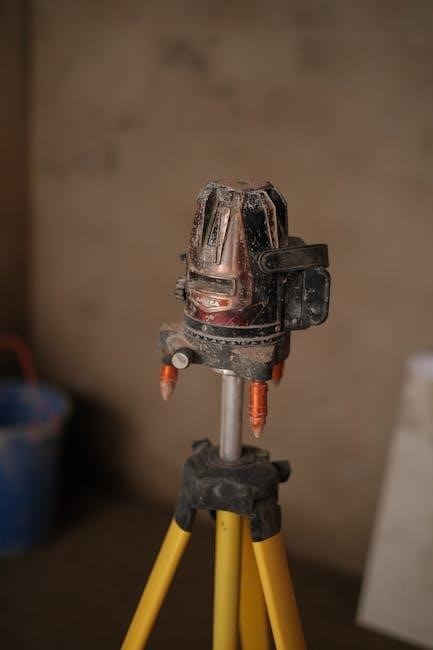PIR (Passive Infrared) sensors detect motion by measuring infrared radiation changes, enabling automation in lighting and security systems. The manual override feature enhances flexibility and control.
1.1 Definition and Functionality of PIR Sensors
PIR (Passive Infrared) sensors are motion-detecting devices that identify changes in infrared radiation, triggered by movement within their field of view. They consist of a sensitivity detector and an integrated circuit, enabling automation in lighting and security systems. These sensors are widely used for energy-efficient solutions, turning lights or devices on/off based on detected motion. The manual override feature allows users to bypass automatic functionality temporarily, providing flexibility in operation. This combination of automation and manual control enhances convenience, safety, and energy efficiency in various applications.
1.2 Importance of Manual Override in PIR Sensors
The manual override feature in PIR sensors offers enhanced control and flexibility. It allows users to switch between automatic and manual modes, ensuring lights or devices can be turned on/off independently of motion detection. This is particularly useful in scenarios where constant illumination is needed, such as during events or maintenance. The override feature also addresses false triggers and provides a backup option during sensor malfunctions. By combining automation with manual operation, PIR sensors with override capabilities offer a balanced solution for convenience, efficiency, and reliability in various applications.

Key Components of a PIR Sensor
PIR sensors consist of an infrared detector, integrated circuit, and lens. The detector senses motion, while the circuit processes signals. The power supply and wiring enable operation. The manual override feature adds flexibility and control to the system.
2.1 Sensitivity Detector and Integrated Circuit
The sensitivity detector in a PIR sensor captures infrared radiation changes, detecting motion accurately. The integrated circuit processes these signals, amplifying and interpreting them to trigger responses. Together, they enable automation, ensuring lights or alarms activate when motion is detected. Adjusting sensitivity levels enhances performance for specific environments, reducing false triggers. This combination of components is essential for reliable operation, making PIR sensors versatile for various applications, from security systems to energy-efficient lighting solutions.
2.2 Power Supply and Wiring Requirements
A stable power supply is crucial for PIR sensor functionality. Typically requiring a 12-24V DC or AC power source, the sensor’s wiring involves connecting power, ground, and output terminals. Proper wiring ensures reliable motion detection and manual override operation. The power wire is threaded through a gasket to prevent damage, then connected according to the wiring diagram. Secure connections are essential to avoid malfunctions. Following manufacturer guidelines ensures optimal performance and safety, making installation straightforward for both professionals and DIY enthusiasts.

Installation and Setup of PIR Sensors
PIR sensors require careful positioning and wiring. Connect power, ground, and output terminals as per the diagram. Mount at optimal height and test functionality to ensure reliability.
3.1 Wiring Diagrams for PIR Sensors with Manual Override
Wiring diagrams for PIR sensors with manual override typically show connections for power, ground, and output. The override feature is integrated into the circuit, allowing manual control. Diagrams often include a switch connected in parallel to bypass the PIR functionality temporarily. Proper wiring ensures smooth operation between automated and manual modes. It’s essential to follow the manufacturer’s schematics to avoid connectivity issues. Always test the setup after installation to confirm both motion sensing and manual override functions work seamlessly together.
3.2 Step-by-Step Installation Guide
Begin by mounting the PIR sensor at the desired height, ensuring optimal coverage. Connect the power supply wires to the sensor’s terminals, following the wiring diagram. Install the manual override switch in parallel to the sensor, allowing temporary bypass of automation. Secure all connections and test the system to ensure both motion detection and manual override functions operate correctly. Adjust sensitivity settings as needed for reliable performance. Finally, verify that the sensor activates lights or devices appropriately in both automated and manual modes, ensuring seamless functionality and user convenience.
3.3 Placement and Mounting Considerations
Ensure the PIR sensor is mounted at an optimal height (typically 2-2.5 meters) to maximize motion detection coverage; Position it to face the target area, avoiding obstacles like furniture or plants that may block its field of view. The sensor should be angled to cover the desired zone effectively. Avoid exposing it to direct sunlight or heat sources, as this can cause false triggers. Secure the sensor firmly to prevent vibration or movement, which might affect accuracy. Strategic placement ensures reliable performance and minimizes interference, making it essential for both automation and manual override functionality to work seamlessly.
3.4 Connecting the Power Supply
Connect the power supply to the PIR sensor by passing the power wire through the provided hole with a gasket for weatherproofing. Refer to the connection-wire diagram for accurate wiring. Ensure the live, neutral, and earth wires are connected correctly to avoid electrical hazards. Secure the connections tightly to prevent loose wiring. Follow the manufacturer’s guidelines for voltage requirements, typically between 12-24V AC/DC. Double-check the polarity to prevent damage to the sensor or integrated circuit. If unsure, consult a licensed electrician, especially for complex installations or smart home integrations. Proper connection ensures reliable operation and safety.

Manual Override Feature
The manual override feature allows users to temporarily bypass the PIR sensor’s automatic operation, enabling permanent activation of connected devices when needed.
4.1 How Manual Override Works
The manual override feature in PIR sensors allows users to bypass the automatic motion detection functionality temporarily. This is typically achieved through a physical switch or setting that disables the sensor’s ability to detect motion. When activated, the override ensures that connected devices, such as lights, remain on continuously until the override is deactivated. This feature provides flexibility for scenarios where constant illumination is required, such as during events or tasks. The override mechanism ensures that users can switch between automated and manual control seamlessly, enhancing the versatility of the PIR sensor system.
4.2 Types of Manual Override Mechanisms
Manual override mechanisms for PIR sensors come in various forms, including physical switches, digital interfaces, and remote controls. Physical switches are the most common, allowing users to toggle between automatic and manual modes directly. Digital interfaces, often integrated into smart systems, enable control via apps or voice commands. Some advanced models feature remote controls for convenient operation. These mechanisms ensure flexibility, catering to different user preferences and system requirements; Each type provides a reliable way to switch modes, enhancing the overall functionality of the PIR sensor system.
4.3 Configuring the Manual Override Duration
Configuring the manual override duration on PIR sensors allows users to set a specific time for the sensor to remain active or inactive. This is typically done using a dial or digital interface. For example, adjusting the LUX knob enables setting the desired light level for activation. Some models feature programmable timers, allowing users to customize how long the override remains in effect. This flexibility ensures the sensor operates according to specific needs, enhancing convenience and efficiency. Proper configuration ensures reliable performance, whether for security, lighting, or energy-saving applications.

Benefits of Using PIR Sensors with Manual Override
PIR sensors with manual override offer automation, convenience, and energy efficiency. They enhance safety and provide flexible control, allowing users to customize operation as needed easily.
5.1 Automation and Convenience
PIR sensors with manual override combine automation and convenience, automatically switching lights or devices on/off based on motion detection. This eliminates the need for manual operation, saving time and effort. The manual override feature adds flexibility, allowing users to bypass automation when needed. For instance, lights can be turned on permanently for specific tasks or events. This dual functionality ensures seamless integration into daily routines, enhancing user experience while maintaining energy efficiency. The ability to customize operation modes makes PIR sensors with manual override ideal for various applications, from residential to commercial settings, ensuring both convenience and practicality.
5.2 Energy Efficiency
PIR sensors with manual override significantly enhance energy efficiency by automatically switching lights or devices on/off based on motion detection, reducing unnecessary power consumption. The manual override feature allows users to disable automation when needed, preventing false triggers and extending device lifespans. This dual functionality ensures energy savings while maintaining flexibility. By minimizing idle operation, PIR sensors contribute to lower energy bills and reduced environmental impact; The ability to customize settings further optimizes energy usage, making these sensors a practical choice for eco-conscious applications.
5.3 Enhanced Safety and Security
PIR sensors with manual override boost safety and security by detecting motion and triggering alerts or lights, deterring potential intruders. The manual override feature allows users to activate systems continuously for added security during high-risk periods. Customizable sensitivity ensures accurate detection, minimizing false alarms. Integration with smart systems enables remote monitoring, offering peace of mind. Enhanced visibility from automated lighting reduces accident risks. This combination of automation and manual control creates a robust security solution, protecting properties and occupants effectively while maintaining convenience and reliability.

Customization and Adjustments
PIR sensors with manual override offer adjustable sensitivity and lux levels, allowing users to tailor performance to specific needs for optimal detection and energy efficiency.
6.1 Adjusting Sensitivity Levels
Adjusting sensitivity levels on PIR sensors ensures accurate motion detection, minimizing false triggers. Turning the sensitivity knob allows customization based on the environment, optimizing performance for specific areas.
6.2 Setting the Desired Lux Level
The desired lux level on PIR sensors with manual override is set using a dedicated adjustment knob. This feature allows users to define the ambient light threshold at which the sensor activates. By rotating the knob, the lux level is fine-tuned to ensure the sensor operates only when natural light falls below the specified threshold. This customization prevents unnecessary activations during daylight. The manual override feature complements this setting by enabling temporary bypass of the lux-level restrictions. Proper adjustment ensures energy efficiency and tailored performance for various lighting conditions.
6.3 Calibration for Optimal Performance
Calibrating PIR sensors with manual override ensures accurate motion detection and consistent performance. Start by adjusting the sensitivity detector to match the environment, reducing false triggers. Next, set the desired lux level to prevent unwanted activations during daylight. Fine-tune the override duration to meet specific needs, ensuring smooth transitions between automated and manual modes. Regular recalibration after installation or setting changes is crucial for maintaining reliability. Proper alignment of the sensor’s field of view and testing under various conditions further enhance accuracy, guaranteeing optimal functionality and energy efficiency in automated lighting or security systems.

Troubleshooting Common Issues
Common issues with PIR sensors include false triggers, connectivity problems, and malfunctioning manual overrides. Check wiring, adjust sensitivity, and ensure proper alignment to resolve these issues effectively.
7.1 Resolving False Triggers
False triggers in PIR sensors often result from improper installation or sensitivity settings. Adjust the sensor’s angle and distance to minimize interference from pets or natural light. Ensure the lens is clean and free from obstructions. Check wiring connections to prevent electrical noise interference. If issues persist, consult the manual or contact technical support for further assistance. Regular maintenance and calibration can significantly reduce false triggers, ensuring reliable performance.
7.2 Fixing Connectivity Problems
Connectivity issues in PIR sensors can often be resolved by checking wiring connections and ensuring proper power supply. Verify that all wires are securely connected to the correct terminals, as loose connections can cause malfunctions. Use a multimeter to test voltage at the sensor to ensure it matches the required specifications. Clean or replace corroded connectors and check for any short circuits. If the problem persists, consult the sensor’s manual or contact the manufacturer for technical support. Ensuring stable power supply and clean connections will help maintain reliable operation.
7.3 Addressing Malfunctioning Override Features
If the manual override feature of your PIR sensor stops functioning, check the override switch for proper connectivity and ensure it is correctly wired. Verify that the switch is properly aligned with the sensor’s circuit. Clean any corrosion on the switch or sensor terminals. If issues persist, reset the sensor according to the manufacturer’s instructions. In some cases, replacing the override switch or consulting the sensor’s manual may be necessary. Ensure the override duration is configured correctly for optimal performance. Regular inspection and maintenance can prevent such malfunctions and ensure reliable operation of the manual override feature.

Best Practices for Using PIR Sensors
Regularly inspect and clean sensors to ensure accuracy. Position sensors away from direct sunlight and heat sources. Adjust sensitivity levels for optimal performance and reliability.
8.1 Regular Maintenance Tips
Regular maintenance ensures optimal performance of PIR sensors. Clean the lens and surrounding areas to avoid dust buildup, which can cause false triggers. Check wiring connections periodically to prevent issues. Replace batteries if applicable, and ensure the power supply is stable. Adjust sensitivity settings as needed to maintain accurate motion detection. Test the manual override feature to ensure it functions correctly. Perform these tasks quarterly or as needed based on usage and environmental conditions. Proper upkeep extends lifespan and reliability.
8.2 Avoiding Common Installation Mistakes
- Avoid incorrect wiring by following the provided diagrams to ensure proper connections for both power and manual override features.
- Ensure the sensor is mounted at the correct height and angle to prevent false triggers or blind spots.
- Do not install PIR sensors near direct sunlight or heat sources, as this can interfere with accuracy.
- Test the manual override function immediately after installation to confirm it works as intended.
- Secure all connections tightly to prevent loose wires, which can cause malfunctions over time.
8.3 Optimizing Sensor Placement
To maximize performance, PIR sensors should be installed at a height of 2.5 to 3 meters for optimal motion detection. Ensure the sensor’s field of view is unobstructed by furniture or vegetation. Position sensors away from direct sunlight and heat sources to minimize false triggers. Test the sensor’s coverage area by walking through the space to identify potential blind spots. Adjust the mounting angle if necessary to achieve full coverage. Proper placement ensures reliable detection and enhances the effectiveness of both automatic and manual override functions, providing consistent performance in various environments.

Integration with Smart Home Systems
PIR sensors integrate seamlessly with smart home systems, enabling remote control and monitoring through voice assistants and smartphone apps for enhanced convenience and automation.
9.1 Compatibility with Smart Home Devices
PIR sensors with manual override are compatible with various smart home systems, including hubs like Samsung SmartThings and Apple HomeKit. They often use Zigbee or Z-Wave protocols for seamless integration. This compatibility allows users to control lighting and security systems remotely via smartphone apps or voice assistants like Alexa. Enhanced convenience and energy efficiency are key benefits, as sensors can be programmed to optimize automation based on occupancy. Compatibility may vary, so checking specifications is essential for a smooth integration experience.
9.2 Remote Control and Monitoring
PIR sensors with manual override can be remotely controlled and monitored through smartphone apps, enabling users to adjust settings or override automation. Voice assistants like Alexa or Google Assistant further enhance convenience. Remote access allows users to check system status, receive notifications, and customize settings. This feature is particularly useful for managing lighting and security systems efficiently. Real-time monitoring ensures users stay informed about sensor activity, even when away. Remote control capabilities provide flexibility and peace of mind, making PIR sensors a practical choice for modern smart home setups.
9.3 Voice Assistant Integration
PIR sensors with manual override can seamlessly integrate with voice assistants like Alexa or Google Assistant, enabling voice command control. Users can activate or deactivate lights, adjust settings, or override automation hands-free. This integration enhances convenience, allowing for effortless management of lighting and security systems. Voice commands provide real-time control, making it easier to customize sensor behavior without physical interaction. Compatible systems ensure a smooth and responsive experience, further elevating the functionality of PIR sensors in smart home environments.

Future Trends in PIR Sensor Technology
Future trends include enhanced sensitivity, AI-driven adaptive sensing, and sustainable energy solutions, ensuring smarter automation and seamless manual override functionalities in smart environments.
10.1 Advances in Sensitivity and Accuracy
Advancements in sensitivity and accuracy are revolutionizing PIR sensors, enabling better motion detection with reduced false triggers. Enhanced sensor arrays and improved algorithms ensure precise tracking, while maintaining compatibility with manual override features. These upgrades allow PIR sensors to adapt to dynamic environments, offering reliable performance in various lighting conditions. Future developments aim to integrate machine learning for personalized detection settings, further enhancing automation efficiency without compromising manual control capabilities.
10.2 Integration with AI and Machine Learning
Integrating PIR sensors with AI and machine learning enhances their functionality by enabling smarter motion detection. Machine learning algorithms can analyze patterns to reduce false triggers and improve accuracy. AI-powered systems can learn from usage data, optimizing sensor performance over time. This integration allows for personalized settings, such as adjusting sensitivity based on specific conditions. Additionally, AI-driven insights can predict and adapt to environmental changes, ensuring seamless operation. The combination of AI and manual override features creates a balanced system, offering both automation and user control for tailored applications.
10.3 Energy Harvesting and Sustainability
Energy harvesting technologies are revolutionizing PIR sensors by reducing reliance on traditional power sources. Solar, kinetic, or ambient light energy can now power these sensors, making them more sustainable. This advancement is particularly beneficial for manual override models, as it ensures continuous operation without frequent battery replacements. Sustainable energy solutions not only lower maintenance costs but also minimize environmental impact. As PIR sensors integrate energy-efficient designs, they align with global efforts to reduce carbon footprints, offering a greener alternative for automation and security systems. This shift supports long-term reliability and eco-friendly performance in various applications.
PIR sensors with manual override offer efficient automation, enhanced security, and energy savings. Their versatility and integration with smart systems make them a reliable choice for modern applications.
11.1 Summary of Key Features and Benefits
PIR sensors with manual override combine advanced motion detection with flexible control, offering automation, energy efficiency, and enhanced security. Their sensitivity detectors and integrated circuits ensure reliable performance, while the manual override feature provides convenience during specific situations. These sensors are ideal for smart home integration, allowing remote monitoring and voice assistant compatibility. With customizable settings like sensitivity adjustments and lux level controls, they cater to diverse needs. Their energy-saving capabilities and durable design make them a practical choice for both residential and commercial applications, ensuring optimal functionality and user satisfaction in various environments.
11.2 Final Thoughts on PIR Sensors with Manual Override
PIR sensors with manual override offer a blend of automation and user control, making them highly versatile for modern applications. Their ability to detect motion while allowing manual intervention ensures convenience and reliability. These sensors are ideal for enhancing security, reducing energy consumption, and integrating with smart systems. With advancements in technology, PIR sensors continue to evolve, providing even greater efficiency and functionality. Their ease of installation and customization make them a practical choice for homeowners and businesses alike, ensuring long-term satisfaction and performance in various environments.



